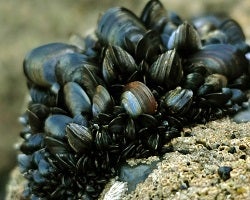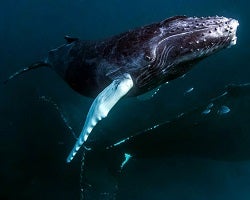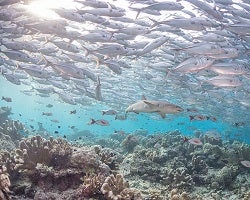What Animals Live In The Marine Biome
Between a Rock and a Wet Place

Mussels clamp tight to avert drying out and to try to keep from existence eaten. Click for more than particular.
It may not seem like it, but the waters of the littoral biome are teeming with tiny critters. These organisms are then numerous that for many animals the bounding main is one humongous bowl of soup.
There is so much food in the waters near the declension that some animals, like the oyster, don't even need to move to find it. They but filter all their nutrient straight out of the water.
We call these animals filter feeders.
Because they don't demand to move around, oysters latch onto difficult surfaces like rocks. The oyster is stuck to its rock and can't swim away when something wants to consume it.

What do mussels and whales have in common? Click to find out.
When a predator comes to see if oyster is on the card, the oyster clamps its shell shut with a stiff musculus.
A Wearisome Attack
Locking itself inside its difficult shell works most of the fourth dimension, but at that place is one predator that tin sideslip past the oyster's defenses. The bounding main star (or starfish) also seems like a motionless sea animal, but in the world of the coastal creatures information technology hunts similar a wolf.
A ocean star has hundreds of tiny feet that tin taste everything they walk over. If they happen to walk over an oyster instead of a rock, they attack! The feet act like little suction cups, grabbing on to both sides of the oyster'due south beat and prying information technology open.
Even if the suction-cup feet can't completely open the oyster's shell, the sea star can turn its stomach inside out, and push it through the crevice in the oyster's vanquish straight into its cushy home. Later on that, it'due south all over. The sea star digests its prey inside the beat out, and after it tucks its stomach back in, all that is left is an empty shell.
Feeding Frenzies

Sardines aren't the just fish that concenter groups of hunters. These jack fish concenter large predators similar sharks that are looking for a meal. Click to enlarge.
These aren't the simply hunters of the coastal waters. Coastal fish have many predators of which they need to be wary. When the seasons change and marine algae starting time to flower, migratory fish like sardines, anchovy, or herring swim upwardly the coast to eat the algae. Big swarms of tasty fish attract speedy predators including sharks, sailfish, sea lions, dolphins, and whales.
The predators work together to push the fish into a brawl well-nigh the surface where they can't escape. That's when the sea birds strike. Many sea birds like gannets, cormorants, puffins, and shearwaters are adapted to dive into the water, while gulls and boundness pick up leftovers from the surface. Sooty shearwaters can dive over 60 m (200 ft) nether water to hunt. Meanwhile, the sharks and other larger predators swim through the brawl, trying to catch a meal.
Additional images via Wikimedia Commons. Gannet by Mike Pennington. Sea star video via Shape of Life http://vimeo.com/shapeoflife
Source: https://askabiologist.asu.edu/animals-coast
Posted by: wallaceborceir.blogspot.com

0 Response to "What Animals Live In The Marine Biome"
Post a Comment